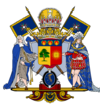Third Thuylemans Government
The Third Thuylemans Government was the third Shirerithian cabinet under Steward Louis Thuylemans, established following the 1735 Shirerithian general elections. It was shortlived, from 1735 to 1737 AN. Its tenure occurred during a particularly tumultuous period known as the Mango Anarchy, characterized by political instability, factional infighting, and a population increasingly disillusioned with either Kaiseress Salome or Louis Thuylemans' leadership. Despite its formation as a coalition government, the cabinet faced constant challenges and struggled to address the crises afflicting the Imperial Republic, including the Shiro-Benacian War.
Its legitimacy was undermined from the outset. The government initially operated from Novi Nigrad, on the island of Yardistan, as escalating unrest and instability in the imperial capital of Shirekeep rendered it unsafe. The government would only return to Shirekeep in late 1736 AN.
Formation of the Government
The 1735 elections saw the Kalirionists, a faction of constitutional monarchists supporting the Kalirion Dynasty, emerge as the largest party in the Adelsraad. However, internal divisions within the Kalirionists created significant hurdles to forming a cohesive government. Royalist sub-groups, representing competing visions for the monarchy's role in Shirerithian governance and who would eventually succeed the Kaiseress. While the largest faction, it failed to align on key policies.
Meanwhile, the Aldricists, a moderate monarchist faction, capitalized on their reputation for pragmatism and their ability to broker compromises. They reached an agreement with the mainline Kalirionist faction to form a coalition government. Despite the alliance, the coalition was fraught with internal tensions, reflecting the broader divisions within the empire.
Constitutional Reforms
The Aldricists, seeking to address the public's dissatisfaction with the Steward's executive powers, pushed for constitutional reforms aimed at enhancing legislative oversight. These efforts included:
- Proposals to strengthen the role of the Folksraad. Something Louis Thuylemans had tried to avoid by holding new elections.
- Increased checks on the Kaiseress' and Steward’s authority, which many saw as overly centralized.
However, these reforms were met with fierce resistance. The Mangoist faction, representing hardline royalists and traditionalists, opposed any reduction in the Steward’s powers. While limited reforms were eventually implemented to appease the public, they were seen as insufficient by both reformists and radicals.
Military Centralization
Due to the ongoing war with the Benacian Union, significant military authority remained centralized. The government argued that this was necessary to ensure an effective war effort, but it further alienated reformist elements and contributed to perceptions of authoritarianism.
Radical Opposition
The Sakugarists, a revolutionary faction, dismissed the government’s democratization efforts as superficial and accused the coalition of perpetuating aristocratic dominance. Their continued radicalization contributed to widespread unrest and posed a growing threat to the government’s stability.
The Verionists, led by Hildebrand Verion, outright rejected the legitimacy of the Third Thuylemans Government. Verion denounced the election as a "blatantly fraudulent exercise in ballot-stuffing," accusing the Aldricists of enabling the return of Vanic (Haraldite) forces to power. His fiery rhetoric galvanized opposition to the government and added another layer of volatility to an already precarious political landscape.
Governance and Decline
Throughout its tenure, the Third Thuylemans Government struggled to project authority. Factional disputes within the coalition often brought the government to the brink of collapse, particularly over the pace and scope of constitutional reforms. The Steward attempted to mediate these conflicts but lacked the political capital to enforce unity. The government’s inability to effectively address public grievances and the perception of political stagnation further eroded its support. The Folksraad and Adelsraad, where radical elements exerted significant influence, became arenas of constant opposition and obstruction, further hindering the government’s ability to function. In 1737 AN, after the government had already returned to Shirekeep, a revolutionary committee overtook and replaced the cabinet with itself.
| |||||||||||||||||||||||||||||||||||||
